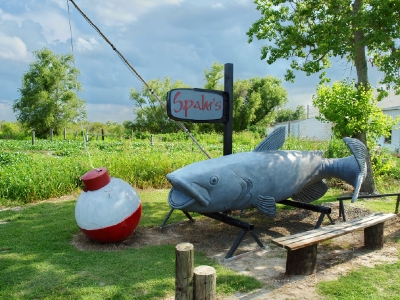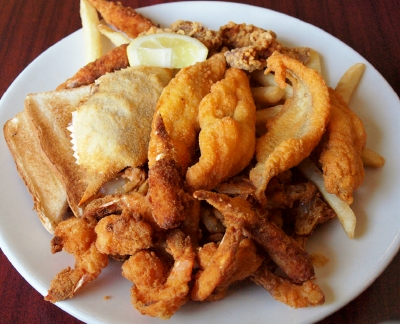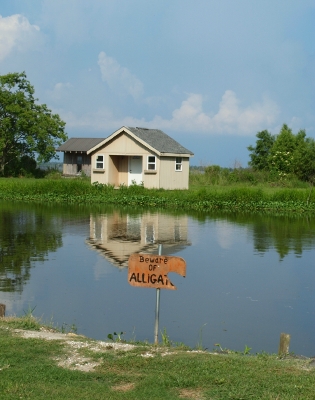
Sunday, June 13. Hungry Town In Houma. Revisiting Old Places. Spahr's Catfish. The action-packed weekend continued with a book signing for Hungry Town in Houma. I get what seems to me an inordinately large number of calls from Houmanians (what are those people called, anyway?) on the radio show, usually telling me about all the great places they have to eat down there. Otherwise, I wouldn't have considered it. It's a small town a long way off.
A two-hour drive, to be exact. I left home around eleven and stayed on the main highways all the way, to make sure I arrived on time. The hardest part was finding the store once I was in Houma. I drove past it three times before I was looking on the correct side of the street and heading toward the sideways-facing front of the big building.
We sold about twenty copies of Hungry Town. Plus the only three copies of my cookbook the store had in stock. We probably could have sold at least twenty more of those.
The interaction between customer and author is sometimes a little tense at these signings. The people who come to buy are no problem, of course. We have a good time talking and joking around. A lot of them want their picture taken with me.
But some people step up not knowing who I am. And, really, why should they? You can hardly hear the radio station in Houma. These are attracted by the generic idea of an actual author of an actual book sitting there. Many of them pick up the book and thumb through it. Which might well sell a book full of photos or maps or even recipes. But Hungry Town is a book you read, not look at, and flipping through it won't grab you unless you happen to stop on the page on which Chef Paul is dumping a pot of sauce over my head.
I know what's going to happen before it does. I try to explain what the book is about while the customer turns the pages slower and slower. Then closes the book, looks at the back cover, then the front cover. Then, slowly, gently, as if not to hurt it, they put it down on the table. And say something like, "I'll have to look into buying this next time I'm here."
I register only the tiniest disappointment when someone doesn't buy my book. I don't expect to sell everybody. Very few people who enter a bookstore buy any given book--even the best-sellers. I feel worse about the customer's minor embarrassment as they reject not only my book but me. It's awkward for both of us, even though we both knew from the outset that no sale would be made. I need to develop a routine to make this moment cheerier. Like:
"Don't worry about it. A half-hour ago another guy bought six copies. He said he was taking up the slack for people who didn't. So you're free to leave!"
I asked everybody who did buy a book where I should eat around Houma. I already had a place in mind: Spahr's, an old Des Allemands catfish house I haven't been to in I couldn't remember how long. I knew Spahr's had opened a branch in Houma, but the original--not long ago rebuilt after a fire--was on my way home. Everybody said that the old place was much better. (Isn't it always?)
The old US 90 is a shorter route than the new highway, but goes through all the towns and takes longer. Sights I barely remembered from long ago alternated with long stretches of development where, last time I looked, there were just treed, bayous, and fields.
The most striking visual came after I crossed Bayou Lafourche in downtown Raceland and headed into the empire of sugar cane fields that lay beyond. Bayou Lafourche was not long ago the Mississippi River, and the land here is high and fertile, perfect for cane.
As soon as the fields closed in on both sides of the road, a gigantic old sugar mill simultaneously loomed into view and emerged from the back of my brain, where its image has rested unexamined for about thirty years. This road has not been US 90 since the 1970s. The spectre of the sugar mill was Proustian for me, and let loose a flood of memories about people, pastimes, and mental states. (Here is an aerial image of the canefields, the sugar mill, and the old highway curving around it.)

That kept me entertained all the way to Spahr's, on the main highway not far from the point where it rejoins the old one. The original Spahr's was in an active Exxon gas station when I first ate there. I remember it's being excellent. As it should be, what with Bayou Des Allemands nearby. The bayou and lakes into which it flows are the most famous source for wild-caught catfish in this part of the world. When a restaurant says it has Des Allemands catfish, it means something.

Preceded by a cup of seafood gumbo, catfish was part of a fried seafood platter. It was the familiar loaded plate, with four or so each of shrimp, oysters, crab claws, and small catfish fillets. (Smaller is better when it comes to catfish.) Also on board were a stuffed crab (in a real crab shell!), fries, and a slice of toast moistened with--is that butter or oil from the fish? I asked myself, for the 693rd time in my life.
All of it was delicious, crisp and hot, each kind of seafood coated differently. Not quite as good as Middendorf's or Bozo's, but almost, and certainly up to the reputation of the place. And generously served for around $15.

I finished up with some raisiny bread pudding, then took a walk around back of the restaurant. They have a sort of rest area back there, with swings and chairs and a few items that would give tourists (and especially their kids) a taste of the bayou. A sign saying "Beware Of Alligator" had a bite taken out of it. A well-detailed ten-foot catfish sculpture went after an equally oversize fishing line.
There was no other way to go than on the main highways the rest of the way home. I was gone eight hours. I don't have that kind of time--not even on a Sunday--but I let myself have it, because seeing these forgotten places was so pleasant. I need to do some more of this.
![]()
![]()
![]() Spahr's Seafood. Des Allemands: 3682 US 90, 985-758-1602.
Spahr's Seafood. Des Allemands: 3682 US 90, 985-758-1602.